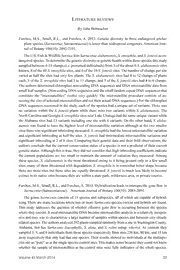
Literature reviews PDF
Preview Literature reviews
. Literature reviews ByJohnBrittnacher Furches, M.S., Small, R.L., and Furches, A. 2013. Genetic diversity in three endangered pitcher plant species (Sarracenia; Sarraceniaceae) is lowerthanwidespread congeners.AmericanJour- nal ofBotany 100(10): 2092-2101. TheU.S. Fish&Wildlife Service listsSarraceniaalabamensis, S. oreophila, andS.jonesiiasen- dangeredspecies.Todeterminethegeneticdiversityorgenetichealthwithinthese speciesthis study sampledbetween4-15 clumps (i.e presumedindividuals) from 3 ofthe about 6 S. alabamensis sites known, 8 ofthe 40S. oreophila sites, and 6 ofthe 10 S.jonesii sites. The numberofclumpsper site varied as halfthe sites had very few plants. The S. alabamensis sites had 8 to 12 clumps ofplants each, 3 ofthe S. oreophila sites had 5 to 11 clumps, and 3 ofthe S.jonesii sites had 4 to 6 clumps. The authors determinedchloroplastnon-coding DNA sequences andDNA microsatellite data from DNA DNA small leafsamples. (Non-coding sequences andthe small tandemrepeat sequences that constitute the “microsatellites” evolve very quickly. The microsatellite procedure consists of as- DNA sessingthe size ofselectedmicrosatellites andnottheiractual sequences.) Forthe chloroplast DNA sequences recovered in the study, each ofthe species had a unique set ofvariants. There was no variation within the S.jonesii plants while there were two variants within S. alabamensis. The NorthCarolinaandGeorgiaS. oreophila sitesnearLake Chatugehadthe sameuniquevariantwhile the Alabama sites had 13 variants including one site with 6 variants. On the other hand, S. alaba- mensis was found to have the highest level ofmicrosatellite variation although at the two smaller sites there was significant inbreedingmeasured. S. oreophila hadthe lowestmicrosatellite variation and significant inbreeding at halfthe sites. S.jonesii had intermediate microsatellite variation and significant inbreeding at 2 of6 sites. Comparing their genetic data and their field observations, the authors conclude that the current conservation status ofa species is not apredictor oftheir current genetic status.Althoughthis is true, they didnot considerthat highinbreeding coefficients indicate the current populations are too small to maintain the amount ofvariation they measured. Among these species, S. alabamensis is the most threatened owing to it being present only in a few small sites, many ofthem threatened with degradation. S. oreophila is in somewhat better shape because there are more sites but those sites are equally threatened. S.jonesii is much less likely to become extinct in its native sites because they are within a state park, wilderness area, orprivate reserve. Furches, M.S., Small, R.L., andFurches,A. 2013. Hybridization leads to interspecific gene flow in Sarracenia (Sarraceniaceae). AmericanJournal ofBotany 100(10): 2085-2091. The genus Sarracenia consists of 15 species and subspecies, all ofwhich are capable ofhybrid- izing. There are manylocations where two ormore Sarracenia species coexist andhybrids are found. This study addresses the question ofwhether effective gene flow is occurring between the species DNA where theycoexist. Itusedmicrosatellite becausemicrosatellite analysis is arelatively inexpen- sive and easy wayto characterize a large numberofsamples within species and betweenveryclosely relatedspecies.Theauthors analyzed292plants sampledrandomlyfroma site inWashingtonCounty, Alabama, that has Sarracenia leucophylla, S. alata, and S. rubra subsp. wherryi. As controls they sampled 5, 9, and6 individuals fromthose species respectivelyfrom sites 250 km, 80 km, and 15 km away respectively that only had that one species. Theirresults showedno individuals at the multispe- cies site as “pure” as atthe single species control sites.Thismakes sensebecausetheycouldnotknow whether the sample ofmicrosatellites at the control sites were fully indicative ofthe whole species. Volume 43 March 2014 33 Theywouldhaveneededtodoafullspeciessurveyofmicrosatellitesforbettercontroldata.Theyused 85% orhigher “pure” as acutoffforpure species inthe multispecies site in orderto not overestimate theproportion ofhybrids. Theyused40 to 60% each oftwo species and less than20% ofthe thirdto classifyfirstgenerationhybrids.Theremainingplantswere classifiedasbackcrossorcomplexhybrids basedonthemicrosatellitepercentagesfromthree species. Usingtheseclassificationstheyfound63% ofthe plants were pure species, 13% were first generation hybrids, 19% were backcross hybrids, and 5% were complexhybrids. They didnot address the issue ofhow a taxonomist wouldhave classified theplantsineachcategory, althoughtheyappeartohavehadthedatatodo so.Theresultsindicatethat gene flowcananddoeshappenbetweenSarracenia species undernatural conditions. The implication ofthis work is that management strategies for conservation ofwild mixed species Sarracenia sites musttake into accountfactorsthathave been shownto increase hybridization. Carstens, B.C., and Satler, J.D. 2013. The carnivorous plant described as Sarracenia alata contains two cryptic species. Biological Journal ofthe Linnean Society 109: 737-746. This paper addresses the issue ofwhether it is time forgenetic data to be used fortaxonomic clas- DNA sificationincaseswheretherearenophysicalcharacterstodistinguish“species”.Ituses sequence data from Zellmer et al. (2012) along with new data filling in missing data from the earlier study in order to make the results more robust. This study, like the previous study, is a tourdeforce ofcutting edge analysis techniques and is important as a demonstration oftheir use. However, it has the same major flaw as the previous paper. They assume the eastern population ofSarracenia alata is geneti- cally isolated from the fourSarracenia species withwhich it co-occurs. Many authors have notedthat interspecifichybridsarefoundintheeasternS. alatapopulations,maldngintrogressionbetweenspecies possible. As reviewed above, Furches et al. (2013) studied a population ofthree Sarracenia species, includingeasternS. alata andshowedthathybridizationappears tohaveresultedingene flowbetween , species. In order for the conclusions in this paper to be valid they have to show the differences they foundbetweenthe eastern andwesternpopulations ofS. alata are based on genetic variants unique to S. alata andnot aresult ofintrogression from other species. The authorspromise a species description tobepublishedbasedonpurelygenetic dataproviding aname forthe westernpopulationofS. alata. References Furches, M.S., Small, R.L., and Furches,A. 2013. Hybridization leads to interspecific gene flow in Sarracenia (Sarraceniaceae). Am. J. Bot. 100(10): 2085-2091. Zellmer,A.J., Hanes, M.M., Hird, S.M., andCarstens, B.C. 2012. Deepphylogeographic structure and environmental differentiationinthe carnivorousplantSarraceniaalata. Syst. Biol. 61(5): 763-777. 34 Carnivorous Plant Newsletter
